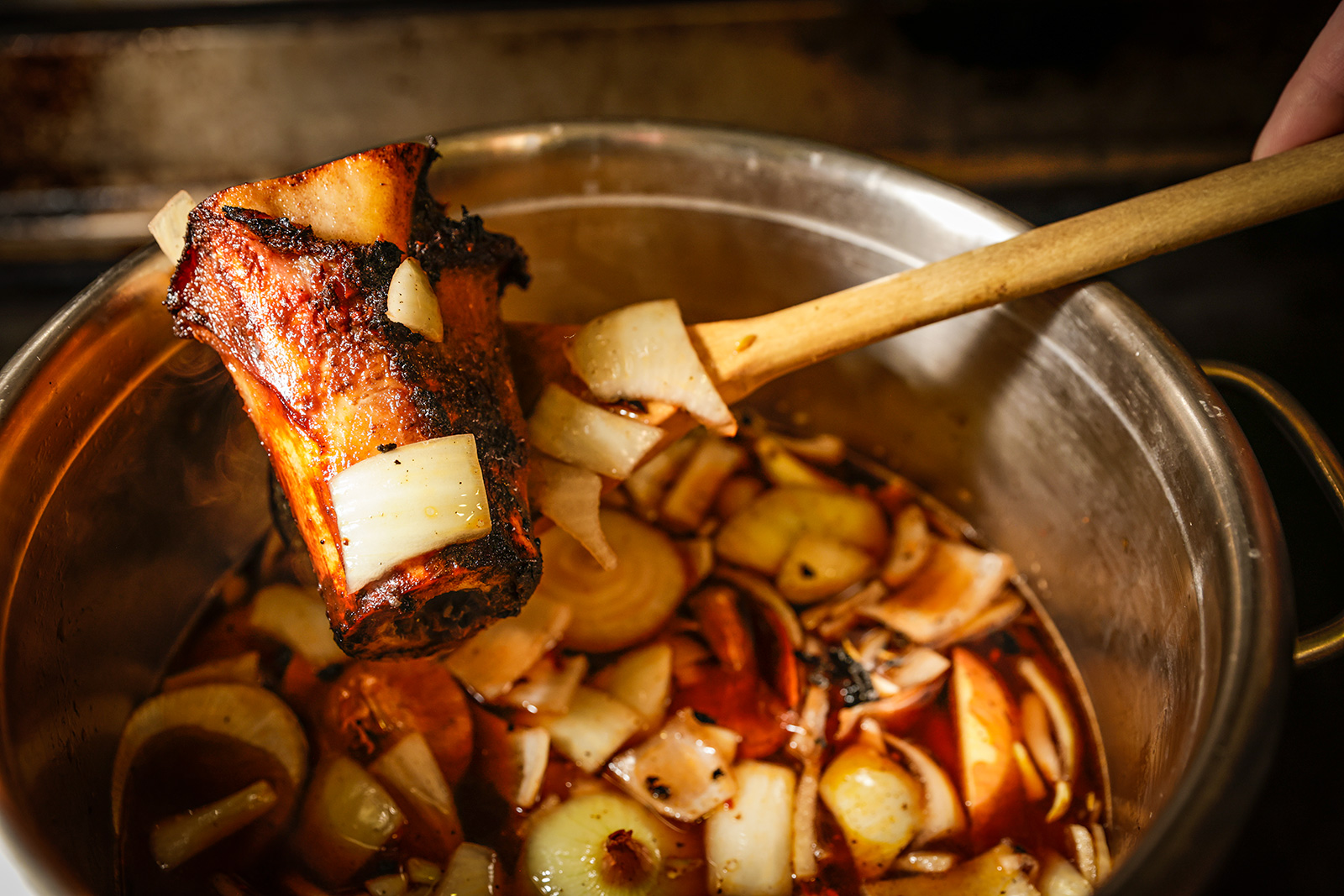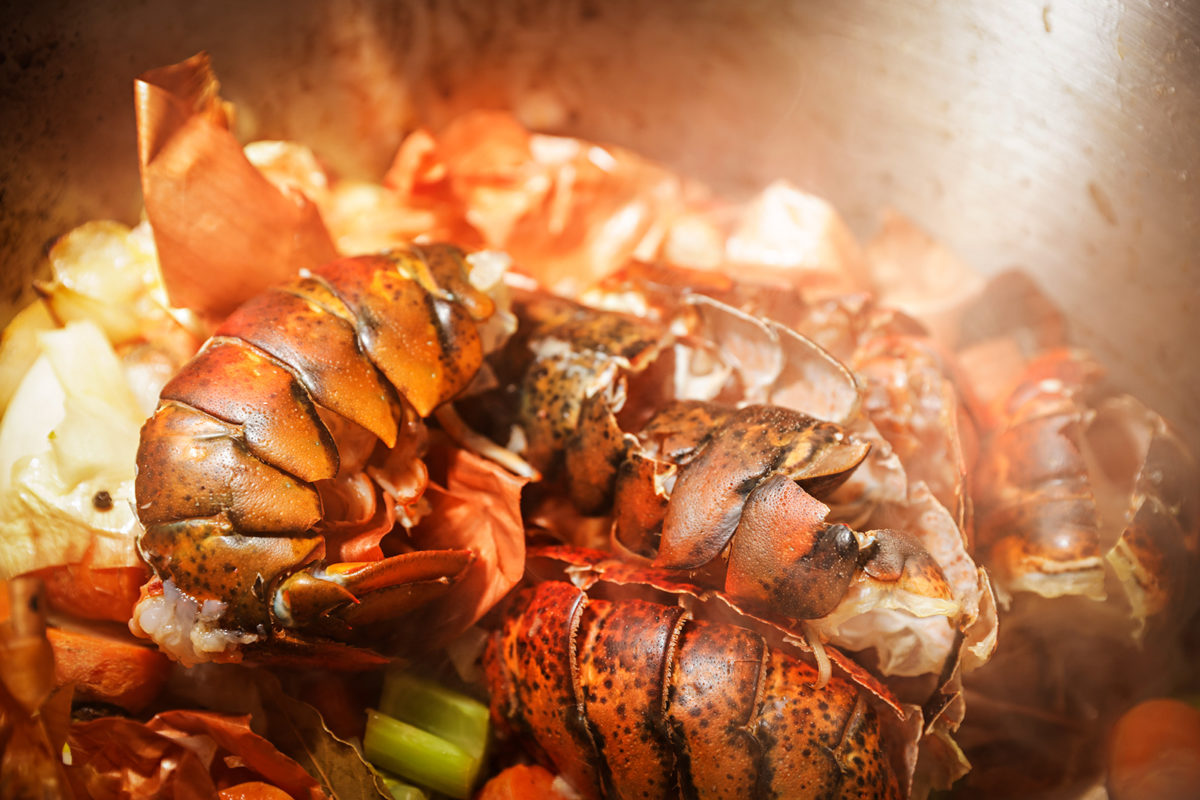For Home Cooks, Making Stock Can Mean Less Waste and More Flavor
Chefs at Great Northern Gourmet restaurant in Bigfork share their trade secrets for home cooks in search of the perfect stock
By Mike Kordenbrock
One of chef and restaurant owner Brad Yaeck’s favorite things is opening the doors to Great Northern Gourmet in the morning and being greeted by the smell of a flavorful stock simmering on the stove range.
What stock that may be could vary on any given day, since the restaurant’s kitchen staff produces several, including a seafood stock with lobster, crab and shrimp, a beef stock and a traditional chicken-based stock.
A pot of stock at the Bigfork restaurant might go on to live one of many lives, including as part of a soup, a sauce, or a dip. The restaurant’s beloved French onion soup owes some of its flavor profile to the au jus, which in itself is made using beef stock that begins with beef bones rubbed in tomato paste, pan-roasted in the oven, and then de-glazed with red wine.
The au jus is so prized that sous chef Mat Wells said they call it “kitchen coffee,” and it’s not unheard of for kitchen staff to heat up a cup to sip on for a pick-me-up on a dreary day. That recipe is a secret held close over decades, and one Wells guessed maybe four people in the valley actually know. Understandably, Yaeck and his crew didn’t reveal the ins and outs of their au jus, but on a recent chilly February afternoon they were more than willing to talk stock, and offer advice for home cooks who might want to try their hand at producing a kitchen staple that can not only cut down on waste, but is so versatile it can enrich any number of dishes.

“It’s hard to screw up,” Wells says, albeit with more colorful verbiage. As the sous chef, Wells is responsible for most of the soup and stock production in the kitchen, and emphasized repeatedly that the best results come from cooking stock low and slow.
“About the only way to mess it up is to turn it on high and go on vacation,” he said.
For a chicken stock Yaeck said the vegetable base typically involves a mirepoix, which is a French term for a mixture of diced vegetables. The chef said they aim for two parts onion, one part carrot, and one part celery. One note from Wells is that home cooks shouldn’t worry about fine, or consistent cuts of vegetable for stock. All the solids will be strained out after the cooking is done unless the stock will be transitioned directly into a soup. A rough chop is totally fine, Wells explained, and onion skins can go into the pot too. They can contribute to the color and also add a richness to the flavor profile. One thing to keep in mind though is to make sure grocery store stickers are removed from the onion skin. Yaeck said they stick to yellow onions and avoid red or sweet onions that could add too much sweetness to the stock. For a more rustic, robust stock, home cooks can try roasting and caramelizing vegetables at the start before adding liquid, Yaeck says.
When it comes to accumulating the vegetables for stock, home cooks could buy the carrots, onions or celery, or they could save their vegetable trimmings and leftovers from day-to-day cooking. At Great Northern Gourmet those vegetable trimmings accumulate so rapidly that they can easily go into a stock before they go bad.
“With prices the way they are at the grocery stores, and limited items, home cooks they definitely want to be able to utilize everything to the fullest without having waste that you throw away,” Yaeck said.

One option for home cooks who might need more time, according to chef de tournant Tristan Conrad, is to throw those extra vegetable bits into a bag and store it in their freezer. Conrad says his girlfriend, who is also a chef, enjoys making vegetable stock and will save all sorts of vegetables in the freezer including basil stems and tomato.
A vegetable stock can be a more rapid cooking endeavor, whereas for a chicken-based stock Wells says that he enjoys letting stocks simmer overnight. “One thing for stocks that’s crucial is the longer you let it go, the better it gets,” Wells said. For home chefs looking for a more prolonged cook for their stock, Wells said a crock pot or slow cooker works well. The lengthy cook will cause some loss of moisture, which can concentrate the stock. Wells said that depending on what the stock will be used for, he’ll aim for a more or less concentrated stock. Covering while cooking can help reduce the amount of water cooked off.
Wells said that in a seafood stock he looks for leaner fish, and typically sticks with shellfish and whitefish. For a chicken stock, bones, leftover bits and scraps of chicken saved in the refrigerator or freezer are all fair game, but Yaeck does not recommend using organ meat. Traditionally a chef might acquire chicken necks and backs for stock because they have the most cartilage, Conrad said.

The carcass from a grocery store rotisserie chicken can be a great stock component, too.
“A lot of people, they go to the store, they buy a rotisserie chicken. Instead of throwing the carcass away, it’s a perfect opportunity to make a stock from it and re-uitilize the product,” Conrad said, noting that even the gelatinous bits at the bottom of the bag will add flavor if included.
“Everything’s flavor,” Wells added.
Herbs and aromatics like parsley stems, thyme, crushed peppercorn, garlic and bay leaf are used in stocks at Great Northern Gourmet, and are usually bundled in cheese cloth and tied up with kitchen twine to create a sachet that can be dropped into the pot and removed easily at a later point like a teabag. Conrad advised against adding salt while a stock is cooking. He made the comparison to using stock like paint, meaning you want to be able to use it with other sauces and things, and so there’s a benefit from having more flexibility with how much salt you want to incorporate into the final dish. Salt can also give stock a cloudier appearance.

At Great Northern Gourmet, after a stock finishes cooking it’s usually strained twice through increasingly fine strainers, and then whatever remaining fat accumulates at the top is skimmed away. The straining process helps with presentation, which may not be as high a priority for a home cook, according to Wells.
One very important tip is to cool down a completed stock as quickly as possible, and Conrad said home cooks might want to make an ice bath in their sink. If it goes into the fridge too hot it could ruin other items in the fridge. If it’s left to cool down to room temperature naturally, there’s a risk of causing serious food-borne illness.
Conrad is a recent graduate of the Culinary Institute of Montana at Flathead Valley Community College, where he said stock-making is among the first skills taught. Stock is so versatile that Conrad said it can even be used as a substitute for water in some dishes.
“We first start off learning how to do all the cuts and different ways to slice vegetables, and instead of just throwing all that product away we throw it into a stock pot and build our stocks from there,” Conrad said. “Stocks are the very fundamentals of it all.”
Of course, there are store-bought options, but Yaeck said going that route comes at a higher cost in terms of money spent and flavor lost. There’s also a satisfaction in using everything in the kitchen to its fullest.
“For me growing up that was a big thing in our family because we grew up on a farm, so everything was used up,” Yaeck said. “There was nothing that went to waste, if there was any kind of waste that couldn’t make it into stock that went to the pig’s trough.”